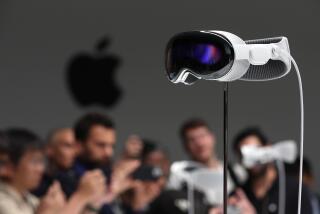Former Apple exec markets a thermostat for the iPhone generation
He was one of the creators of the iPod and the iPhone.
Now former Apple executive Tony Fadell is trying to bring some of that magic to a gadget that is an afterthought in most homes.
Called Nest, it’s a smart thermostat geared to the iPhone generation. It’s designed to learn homeowners’ schedules and surroundings and keep them comfortable while saving them money on energy bills. Nest can also connect to a home Wi-Fi and be remotely controlled with a smartphone, tablet or laptop. With its brushed stainless steel dial, it looks smart, too, Fadell said.
With Silicon Valley backers and advisors, Fadell is looking to shake up the heating and cooling industry that for decades has mass produced plain white or beige thermostats that require complex manuals to program.
The market for thermostats is ripe for a high-tech newcomer, said Chet Geschickter, a senior smart grid analyst for GTM Research, a renewable energy research firm in Boston.
“You practically have to be an HVAC engineer to use the programmable thermostats on the market,” Geschickter said. “Only one person in my home knows how to work the thermostat. If I get hit by a bus on the way home, everyone is going to be very uncomfortable for a really long time.”
But with energy prices still relatively affordable, will consumers pay as much for a device that hangs on the wall as they would for a phone that connects them to the world?
Analysts say the $250 price tag could turn off all but the most environmentally conscious consumers who spend thousands of dollars for solar panels and other home energy management systems. The device goes on sale in mid-November.
“People are much more likely to get in line at the Apple store for the new iPhone than to get in line at Home Depot for a fancy new thermostat,” Geschickter said. “You can throw down rational arguments about how you are going to save X amount of money in energy per year, but at some point you just end up in a small sub-segment, which is those people who want the best of everything for their homes.”
The typical single family home in the U.S. racks up an annual energy bill of $2,200, with heating and cooling accounting for about half the energy consumed, according to the U.S. Department of Energy. Yet nearly 9 out of 10 homeowners rarely or never program the home thermostat.
Homeowners at the high end of the market already have an array of fancy energy management options. Nest is looking to cast a wider net, much the way Apple approached the mobile phone market with the iPhone, said Gartner Research’s lead analyst on the smart grid, Zarko Sumic.
“What this company is doing is building a better mousetrap,” Sumic said. “They are making the thermostat user friendly so people will start using it more and start getting some benefit from it. Then they can start scaling up.”
Getting the average homeowner to take an interest — and make an investment — in managing energy is a chronic problem for the industry. But it’s the wave of the future, and utilities, service providers and a slew of technology companies are all trying to figure out how to get people to open their homes and wallets. According to Parks Associates, 17% of U.S. households will have some form of in-home display for monitoring energy consumption by 2015. By 2021, nearly half of households will have an energy management network, the research firm forecasts.
One potential snag: Collecting homeowners’ energy consumption data could raise privacy concerns, Sumic said. Fadell said Nest would not share homeowners’ data with third parties and would use it only to help homeowners save energy.
Fadell dreamed up Nest when he looked at the thermostat that was supposed to run his state-of-the-art heating and cooling system for the energy-efficient home he was building near Lake Tahoe. Through research he said he learned that 10 million thermostats are installed in U.S. residences every year. He launched his Palo Alto company, Nest Labs, in 2010.
Fadell, who developed hand-held devices for companies and on his own before selling Apple on building an MP3 player in 2001, said he’s looking to snap up a piece of the thermostat market by marketing a device that he said was as simple and intuitive as the iPhone or iPod.
Nest programs itself based on the temperatures that homeowners set and automatically turns down the heating or cooling systems when they are away. It tracks the temperatures homeowners typically set and displays a green leaf as a reward when they choose a more energy-efficient setting. An energy history displays how much energy homeowners save.
The thermostat will be available for pre-orders Tuesday at https://www.nest.com and https://www.bestbuy.com, with rollout to retailers in mid-November. The company says the thermostat is as easy to install as a light fixture and takes about 20 minutes; the company even sends the screwdriver. Or customers can hire a certified installer through its website.
“It’s already a healthy market,” Fadell said. “If we just take a nice percentage of that market, that’s great.”
Fadell would not say how much money his company has raised from Kleiner Perkins Caufield & Byers and other venture capital firms, only that it was substantial. He also would not discuss future updates or products.
Nest’s 100 staffers include former iPod and iPhone lead engineer Matt Rogers and hail from Apple and other top Silicon Valley companies. Silicon Valley pioneer and Apple board member Bill Campbell is an advisor to the company.
More to Read
Inside the business of entertainment
The Wide Shot brings you news, analysis and insights on everything from streaming wars to production — and what it all means for the future.
You may occasionally receive promotional content from the Los Angeles Times.










